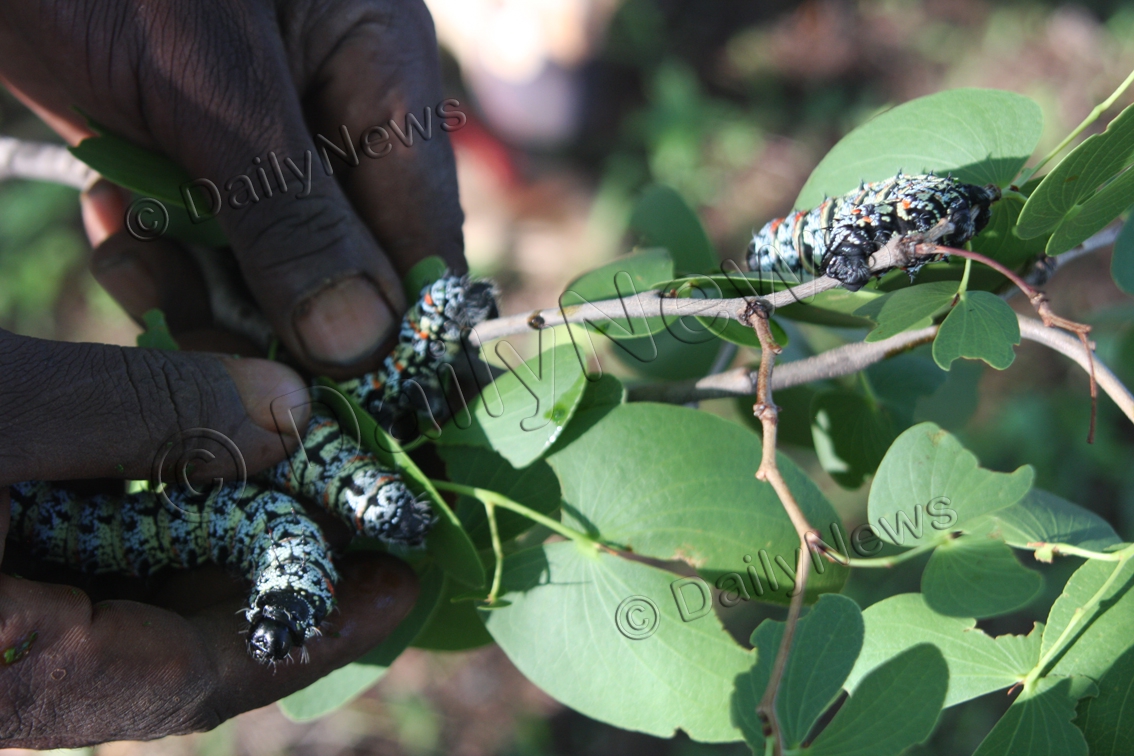Mophane worms - Treat for taste buds
20 Jan 2020
While traditionally, the mophane worm or phane as it is called in the vernacular, was harvested only for consumption at household level, this delicacy has now turned into a money spinner.
Some people who carry the burden of providing for the family, particularly women, often take up whatever lawful means they may come across in efforts to meet the needs of their families.
One such venture that comes at least twice each year, first around November and December and thereafter around April of the subsequent year, is phane harvesting.
Usually after weeks of rainfall, the worms can be seen clinging to and feeding off on the leaves of the mophane tree and soon groups of people will be seen travelling in open cars with different forms of makeshift camping equipment as well as household utensils especially buckets heading to where the worm is.
Some would hire trucks to transport them to the harvesting sites in exchange of bucket-fulls of phane as payment.
Harvesting phane entails camping for some days at harvesting site with all the necessary camping equipment and materials such as tents, cooking utensils and bathing materials.
During the recent harvesting period, phane harvesters could be spotted in different locations in the Tswapong and Bobirwa areas.
At Mmakgabo lands near Lerala, one Ms Elizabeth Mmereki, who was among a group of harvesters camping there, described phane harvesting as no small feat.
She said in addition to the exercise being difficult and labour intensive, phane harvesting was tiring as it entailed moving from one tree to another until one has filled their buckets.
Bravery is a requirement she said because when preparing phane, one has to squeeze out the contents of the worm’s gut, a process that could be considered disgusting by some.
One has to ensure they carry out the task thoroughly, to ensure the worm does not end up with a bitter taste.
Once collected and cleaned, Ms Mmereki said phane would be cooked for some minutes with water and salt before being dried in the sun prior to being stored.
“When you squeeze the gut from phane a thick green liquid comes out”, she said.
Its skin is pricky, requiring one to be careful when handling it, lest they end up with sore hands, stated Ms Mmereki.
She said the hands also get stained by the fluids from the worm hence harvesters wear gloves for protection though some still prefer to use bare hands.
Another tip she said was for one not to carry the task in their treasured clothes because to get them clean again would be a daunting task.
Once dry, it can be eaten cooked or as is.
Ms Mmereki said they were surprised that though phane had been depleted in Tswapong area, it re-surfaced after some years, something that the area’s residents are thankful for as they will not travel long distances in search of it.
Ms Kegomoditswe Sam was among people who camped in the bush at Seokeng lands near Moletemane to harvest phane. She said she manages to harvest at least two 20 liter buckets of phane in a day.
On a normal day, she said she does piece jobs in Ramokgonami where she stays and was struggling to survive from the money that she got. She said through harvesting and selling phane she would raise money which she will use to fend for her family.
She said she regards phane as a source of livelihoods because many of those who camped with her at Seokeng lands depend on it to raise some income. She said they always have a standard price for phane. They sell a cup of phane for P10.
She said phane tastes nice depending on how it is prepared. Likewise, she said there are many ways to cook phane.
Another harvester, Mr Nelson Latlhang who was also at Seokeng lands said that when they collect phane they prefer to collect it from short trees because that is where it is easily accessible. He said they also prefer to let phane to grow big enough before they harvest it.
He said phane eats a lot and can finish all the leaves in a mophane tree during its continuous feeding habit. He said after finishing the leaves in one tree, they would move on to the next tree and they (phane harvesters) would sometimes collect it on the ground.
Mr Latlhang said he has been involved in the selling of phane years ago and was optimistic that he will get high returns.
He said when they camp in the bush they are aware that they are exposed to risks such as getting lost in the bush and being bitten by snakes.
However, he said they are always cautious and ensure that they are safe at all times. Ends
Source : BOPA
Author : Portia Rapitsenyane
Location : MOLETEMANE
Event : Interview
Date : 20 Jan 2020






